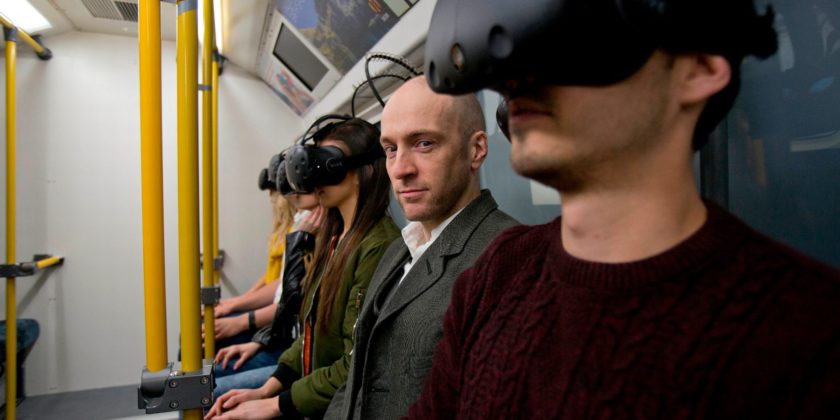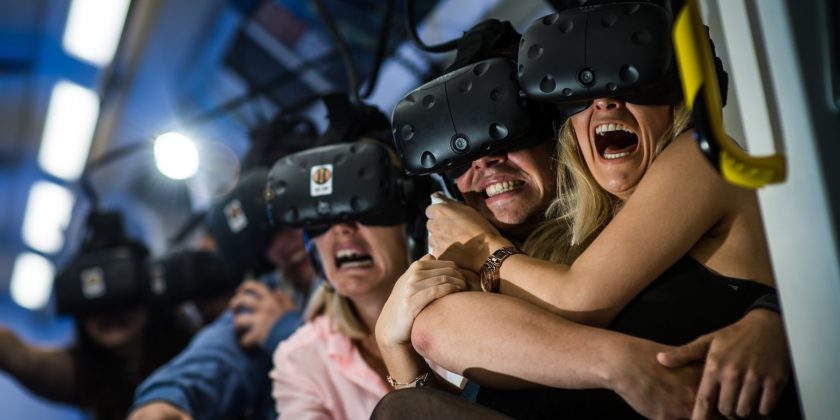“I firmly believe that this kind of multi-sensory, mind blowing attraction represents a glimpse of what the future holds for theme parks the world over,”
-Derren Brown
When Figment Productions partnered with Merlin Entertainments and Derren Brown to produce Thorpe Park’s ghost train ride, scares were at the top of the agenda. Virtual reality combined with real life action to create a multi-sensory experience of grand illusion; blurring the lines of reality.
Three years in the making, the team worked closely with Derren Brown from initial concept through to its launch in 2016. Following the initial launch, the ride was revised in 2017, which included a re-fit and previously impossible updates to the VR content to make it even more scary. Commuting will never be the same again!

About the Ride
Figment Productions was tasked with developing the VR experience element of this new Ghost Train ride. The immersive experience provides the central element of the ride, which blends real life with two separate phases of the VR experience, taking riders into a post-apocalyptic world where demons are taking over.
Unlike other rides, the experience starts before the rider sets foot on the ride. Situated in a giant warehouse, riders enter via a waiting area where they get on what looks from the outside like a Victorian train carriage, suspended in the air. Playing with riders’ perceptions, when they go into the train, they are transported into a modern day underground carriage, with a VR headset on each seat.
Once in the virtual space, riders enter a journey of horrors, faced with demons taking over the carriage and attacking virtual passengers. The VR experience mixes VR with sensory elements, as well as having actors involved in the action.
Development and Challenges
Making characters believable
“Fundamentally, expectations in a theme park experience are different from a games experience, there is still a willing suspension of disbelief, but the parameters are different. The whole point of the experience is to question what’s real at all times.” Simon Reveley, Founder and CEO, Figment Productions.
The Figment team used a mixture of creative approaches, pushing the boundaries of what was possible by experimenting with cutting-edge techniques to develop a believable and terrifying experience. Merging the real and virtual worlds meant that instilling a sense of realism in the VR experiences was crucial to the success of the whole project, so creating stylised characters wasn’t an option. “If you don’t have characters that look, move, talk and emote completely realistically, people don’t buy that they are real”, says Simon.
This provided the team with a significant challenge during the development of the VR experience at the start of the project back in 2014. Initially they approached the development of realistic human characters by using photogrammetry, however this was problematic. “The issue with this approach was that although they looked amazing, they didn’t move and communicate in a way that looked absolutely real.” explains Simon. “So we had to change our approach, as this would have compromised the overall experience and jarred with the real world.” The team overcame this issue by shooting real life actors with a 3D multi-camera rig at their studio in Guildford, Surrey.
Making it seamless
Developing a VR experience as part of a ride that didn’t exist was another challenge faced by the Figment team. By the time the physical space was in situ, 70-80% of the VR experience had been created. This proved challenging when developing a VR experience that had to sit seamlessly within a real-world ride. The Figment team were fortunate to have the space in and around its studio to create a copy of parts of the ride, and this was where the majority of the testing took place. As the final ride had to be tightly stage-managed, they didn’t just test the VR elements, but also how they integrated with the physical space. This included testing how long it would take for people to work their way onto and around the ride, including the ease of putting on and taking off the VR equipment safely.
On site challenges
Having 60 people using HTC Vives at the same time presented a significant challenge for the team in various ways. With 173 active units (each consisting of a PC, special effects rig and VR headset) in use during each ride, equipment had to be durable; especially as the ride itself moves significantly throughout the experience and each piece of kit must be thoroughly cleaned every five minutes to accommodate new riders. Additionally, to maintain the blurring of lines between the real and virtual worlds, ensuring headsets could be easily put on and removed was crucial. To address these issues, kit was modified to simplify this process, therefore minimising potential damage and limiting the impact on the immersive experience.
By working closely with the team at HTC Vive, Figment were able to create a solution to track the 58 VR headsets in each moving train carriage, with just six lighthouses.
Although the VR systems were designed by Figment working in close collaboration with prime contractor Simworx, who delivered the overall AV and ride control system integration, the experience had to be something that could be maintained and controlled by the team at Thorpe Park. This also raised new challenges, given it was a completely new range of equipment for the park. Operators and on-site technical support teams had to be fully trained to ensure the equipment was effectively maintained, in addition to hosts who contribute to the immersive experience by guiding riders through the whole ghost train experience to, ensuring that the worlds blend as seamlessly as possible.
Sound
Great imagery wasn’t the only crucial element in adding realism to the experience; sound was equally as important. “Good spatial audio was tricky to achieve given the large numbers of people participating in a limited space – not least because of all the screaming!” explains Simon. Having other participants making noise, such as screaming, was something the team couldn’t control. During the first iteration of the ride this conflicted with the rider’s experience, as the sounds they were hearing wouldn’t necessarily fit with what they were seeing in the virtual space. When modifying the ride for its second iteration, the team were able to embrace that side effect, and now the real trains were available for filming, new content was created depicting multiple visitors sitting around each rider on the train, finally giving ample justification for all the screaming.

The Future
“I firmly believe that this kind of multi-sensory, mind blowing attraction represents a glimpse of what the future holds for theme parks the world over.”
-Derren Brown
Simon believes that by pushing the boundaries of technologies and combining this with a strong creative direction, Derren Brown’s Ghost Train is way ahead of its time and it has been positively received by both riders, as well as by those working within the industry from around the world, winning huge recognition with ‘Outstanding Achievement’ at the 2018 Thea Awards – the Oscars of the theme park industry.
Rides featuring immersive technologies have a long history and a long-term future in theme parks. In an industry based on a constant supply of new experiences to attract, thrill and scare visitors, the problem theme parks face with traditional rides is that once they are built, they are difficult to change, so many have limited lifespans. Embracing immersive technologies offers theme park owners an attractive business prospect; it is a cost-effective way to produce new experiences – and update them to created new experiences.